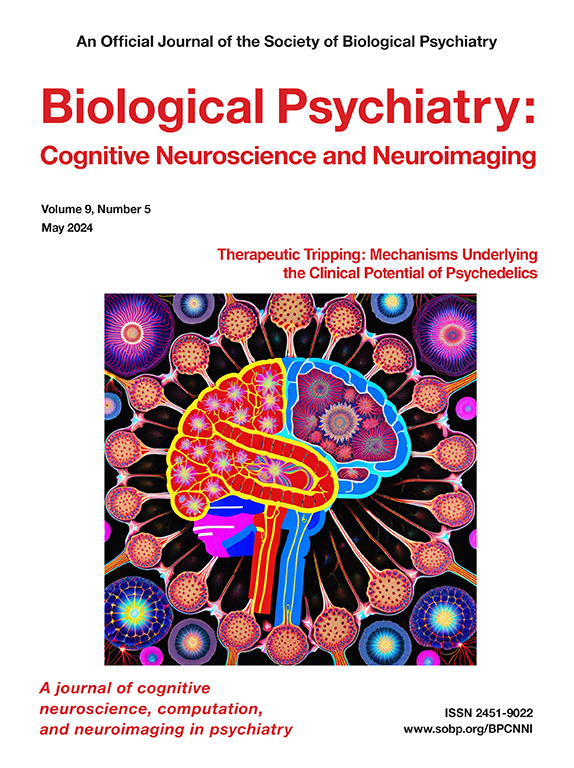随着注意力缺陷/多动障碍儿童认知需求的变化,大脑功能网络组织和动态的重新配置。
IF 4.8
2区 医学
Q1 NEUROSCIENCES
Biological Psychiatry-Cognitive Neuroscience and Neuroimaging
Pub Date : 2025-08-01
DOI:10.1016/j.bpsc.2024.11.006
引用次数: 0
摘要
背景:注意力缺陷/多动障碍(ADHD)的病理生理学特征是不典型的大脑网络组织和动态。虽然大脑功能网络在不同的认知环境中会适应性地重新配置,但以往的研究主要集中于静息状态下的网络功能障碍。这项初步研究考察了30名多动症儿童和36名发育典型(TD)儿童(8-12岁)在休息状态和两项认知要求不同的认知控制任务中大脑功能网络组织和动态是如何灵活重组的:方法:我们利用图论分析来研究前顶叶网络、丘脑/大脑皮层网络、默认模式网络、躯体运动网络和视觉网络的分离(模块化、模块内程度)和整合(全局效率、节点解离指数)。我们还进行了边缘时序分析,以量化这些网络内部和之间的连接动态:结果:在静息状态和基于任务的状态下,多动症儿童的默认模式网络和视觉网络之间的全图模块化程度明显较低,节点解离指数较高。此外,在前顶叶网络的模块内程度方面,观察到了明显的任务与诊断之间的交互作用,多动症儿童的模块内程度从静息状态到任务状态都有所下降,而TD儿童则有所上升。最后,多动症儿童在脑盖/脑髓、默认模式和躯体运动网络内部和之间的动态连通性明显更高,尤其是在完成任务时。探索性分析揭示了网络动态性、认知表现和多动症症状之间的关联:通过在不断变化的认知需求中整合静态和动态网络分析,本研究为了解多动症儿童的特定情境、一般情境和时间刻度依赖性网络连通性如何发生改变提供了新的视角。我们的研究结果凸显了联想和感觉/运动系统在多动症中的参与性和临床相关性。本文章由计算机程序翻译,如有差异,请以英文原文为准。
Reconfiguration of Functional Brain Network Organization and Dynamics With Changing Cognitive Demands in Children With Attention-Deficit/Hyperactivity Disorder
Background
The pathophysiology of attention-deficit/hyperactivity disorder (ADHD) is characterized by atypical brain network organization and dynamics. Although functional brain networks adaptively reconfigure across cognitive contexts, previous studies have largely focused on network dysfunction during the resting state. In this preliminary study, we examined how functional brain network organization and dynamics flexibly reconfigure across rest and 2 cognitive control tasks with different cognitive demands in 30 children with ADHD and 36 typically developing children (ages 8–12 years).
Methods
We leveraged graph theoretical analyses to interrogate the segregation (modularity, within-module degree) and integration (global efficiency, node dissociation index) of frontoparietal, cingulo-opercular/salience, default mode, somatomotor, and visual networks. We also conducted edge time series analyses to quantify connectivity dynamics within and between these networks.
Results
Across resting and task-based states, children with ADHD demonstrated significantly lower whole-graph modularity and a greater node dissociation index between default mode and visual networks. Furthermore, a significant task-by-diagnosis interaction was observed for frontoparietal network within-module degree, which decreased from rest to task in children with ADHD but increased in typically developing children. Finally, children with ADHD displayed significantly more dynamic connectivity within and across cingulo-opercular/salience, default mode, and somatomotor networks, especially during task performance. Exploratory analyses revealed associations between network dynamics, cognitive performance, and ADHD symptoms.
Conclusions
By integrating static and dynamic network analyses across changing cognitive demands, this study provides novel insight into how context-specific, context-general, and timescale-dependent network connectivity is altered in children with ADHD. Our findings highlight the involvement and clinical relevance of both association and sensory/motor systems in ADHD.
求助全文
通过发布文献求助,成功后即可免费获取论文全文。
去求助
来源期刊

Biological Psychiatry-Cognitive Neuroscience and Neuroimaging
Neuroscience-Biological Psychiatry
CiteScore
10.40
自引率
1.70%
发文量
247
审稿时长
30 days
期刊介绍:
Biological Psychiatry: Cognitive Neuroscience and Neuroimaging is an official journal of the Society for Biological Psychiatry, whose purpose is to promote excellence in scientific research and education in fields that investigate the nature, causes, mechanisms, and treatments of disorders of thought, emotion, or behavior. In accord with this mission, this peer-reviewed, rapid-publication, international journal focuses on studies using the tools and constructs of cognitive neuroscience, including the full range of non-invasive neuroimaging and human extra- and intracranial physiological recording methodologies. It publishes both basic and clinical studies, including those that incorporate genetic data, pharmacological challenges, and computational modeling approaches. The journal publishes novel results of original research which represent an important new lead or significant impact on the field. Reviews and commentaries that focus on topics of current research and interest are also encouraged.
 求助内容:
求助内容: 应助结果提醒方式:
应助结果提醒方式:


